The Australian Frilled Lizard
Also Called Frilled Neck Lizard Or Frilled Dragon
The Australian Frilled Lizard is the most popular of our lizards because of its unusual looks and behaviour.
It has many other names: Frill Neck or Frilled Neck Lizard, Frilled Dragon, and often it is affectionately dubbed "Frilly". (That's us Aussies, two syllables is all we can handle...)
These very distinctive lizards are world famous, as they are so photogenic...
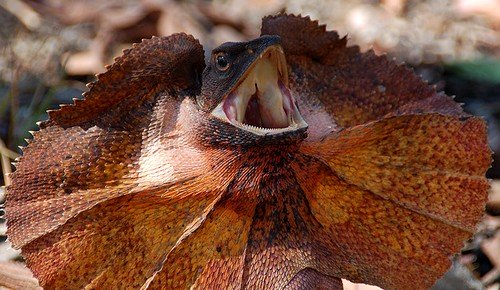
Photo by "wouter!"
They are the reptile emblem of Australia (our animal emblem is of course the kangaroo), and they used to feature on our currency (but we don't have two cent coins anymore.)
Frilled Neck Lizards certainly do their best to look like a scary dragon when they feel threatened, but looks is all there is to it. They are perfectly harmless.
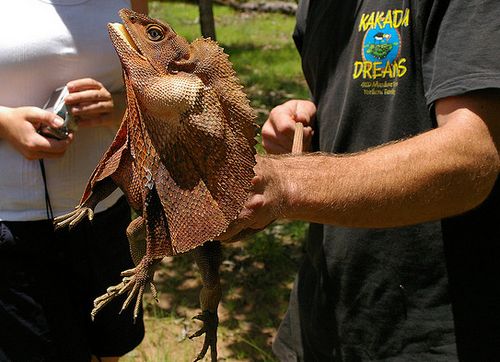
Photo by Trevor Page
Wait till you see them running, it looks so funny, you probably can't help laughing.
Frilled Lizard Facts
Australian Frilled Lizards (Chlamydosaurus kingii) belong to the family of dragons, as the name Frilled Dragon indicates (the proper scientific name of the family is Agamidae).
They are a fairly big lizard, growing to over 90 cm (ok, the tail makes up about two thirds of that length), and weighing up to half a kilo.
Frilled Neck Lizards rely on camouflage for their safety, so their mostly grey and brown colours match those of their surroundings.
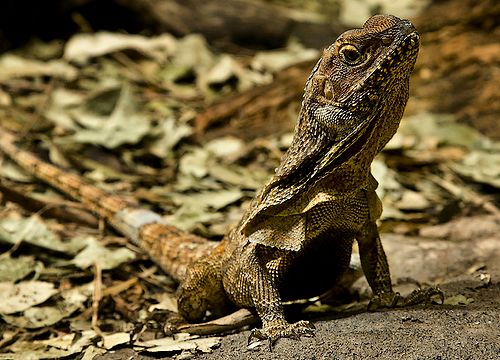
Photo by Trevor Dennis
Lizards from different regions will have different colours. The only brightly coloured body part is the actual frill around their neck, which often contains bright red and orange scales.
The frill is usually folded back around the shoulders and the colours are hidden. It helps the lizard to look like the branch it is sitting on.
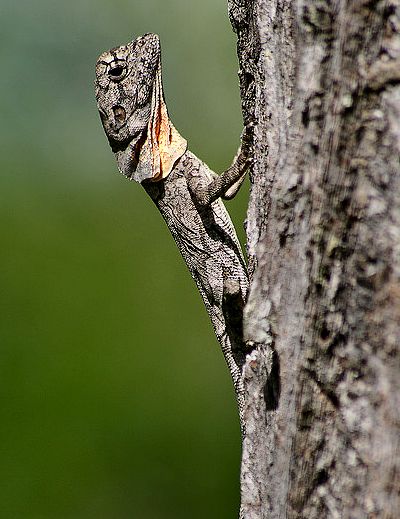
Photo by Bill Higham
To open the frill the lizard opens its mouth widely. Somehow the muscles of the jaw and the tongue are connected to some cartilage in the frill, opening the frill like an umbrella.
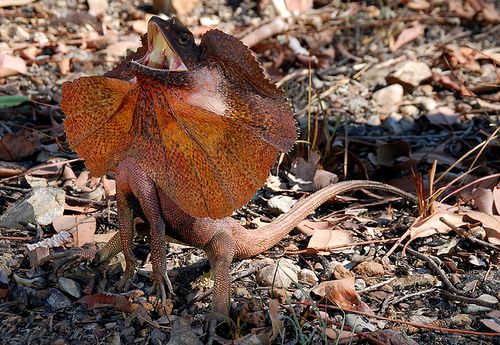
Photo by "wouter!"
The startling bright coloured frill, nearly a foot across (usually 20 - 25 cm), the mouth wide open displaying the strong teeth... The Frilled Lizard now looks very dangerous indeed. Until it starts running that is...
Frilled Lizard Habitat
Like most lizards our Frill Neck Lizards prefer warmer climates.
Although often referred to as Australian Frilled Lizards they are in fact at home in Papua New Guinea, too.
In Australia they live across the tropical north and along the east coast.
Frilled lizards used to be found as far south as Brisbane.
But their numbers on the populated east coast are rapidly diminishing for the usual reasons: habitat destruction, pollution, land clearing etc. Too many people...
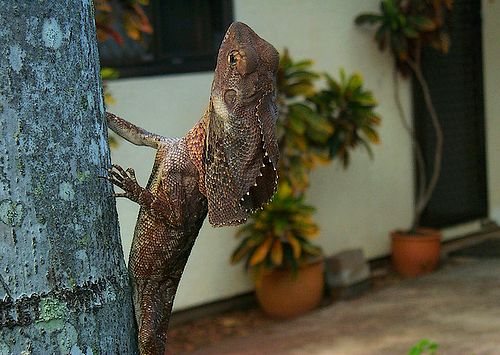
Photo by Stephen barnett
Luckily most of northern Australia is rather devoid of people, and Frilled Neck Lizards are still plentiful here wherever there are trees.
Another concern is predation of Frilled Neck Lizards by feral cats. Cat numbers are exploding all across northern Australia, and our birds and lizards don't stand a chance against this highly efficient killer. The Frill Neck Lizard is no exception.
Frilled Lizard Behaviour
Frilled Neck Lizards are tree dwellers and excellent climbers. In fact, they spend over 90% of their time in trees.
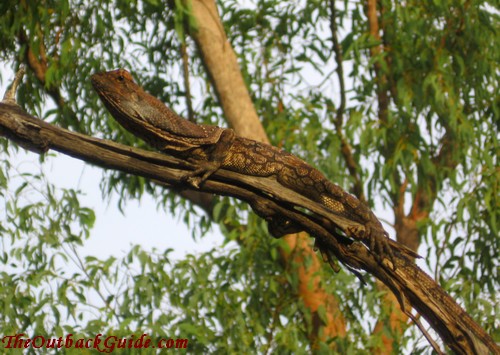
Australian Frilled Lizards are carnivorous and hunt for their food in trees and on the ground. In the trees they find spiders, cicadas, beetles etc., and on the ground more of the same plus ants and even other small lizards. Their eye sight is excellent and they are very fast. If they spot something from a tree they drop to the ground, grab it and are back up on the tree within seconds.
As I mentioned above, they mostly rely on camouflage to protect themselves. Whether in the tree or on the ground, a Frilled Neck Lizard with its frill folded around the shoulders, lying down and perfectly still, blends in very well with its surroundings and is hard to spot.
If you do spot a Frilled Lizard on a tree it's still near impossible to take a photo: as you approach the tree the lizard moves around the trunk to the other side. And as you go around to the other side the lizard does the same, always remaining exactly on the opposite side, while both of you try to sneak a look at the other...
The story is a different one if a Frilled Lizard is on the ground. Again, first it tries to be "invisible". Once a Frill Neck Lizard realises that its cover is blown it changes its strategy:
The lizard opens its mouth to expose the strong teeth, which also opens the impressive orange frill, making the lizard look twice as big.
In addition it rears up on the hind legs, hisses, thrashes its tail on the ground, and it might even jump towards an attacker hoping to scare them off.
My dog was impressed.
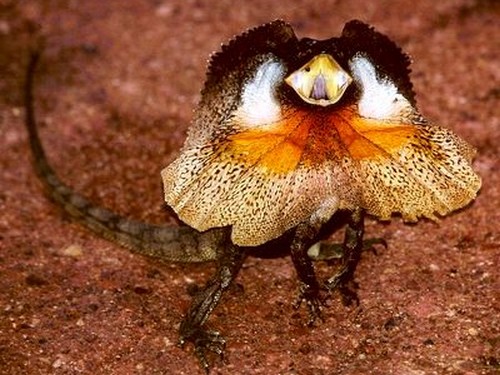
But if our Frilly Lizard realises that the attacker is not impressed it turns and runs for the nearest tree for safety, using the hind legs only. That's when the "attacker" doubles over laughing... They look so funny when they run...
Frilled Neck Lizards breed during the northern wet season. Mating occurs as early as September. A couple of months later the female lizard will lay a clutch of about a dozen eggs (give or take a few) in the ground, and that's as much effort as she puts into it. (The male had to do all the dancing and courting, fighting off other males etc.)
If nobody raids the nest (there are plenty of creatures that might...) the young will hatch sometime around February and be on their own. But at least they have a frill...
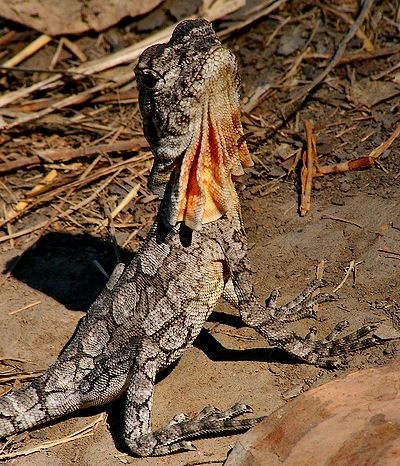
Photo by Bill Higham
Read about other Australian Lizards | Return to top
All Australian Animals | Australian Outback Animals
Return from Australian Frilled Lizard to Outback Australia Travel Guide home page





